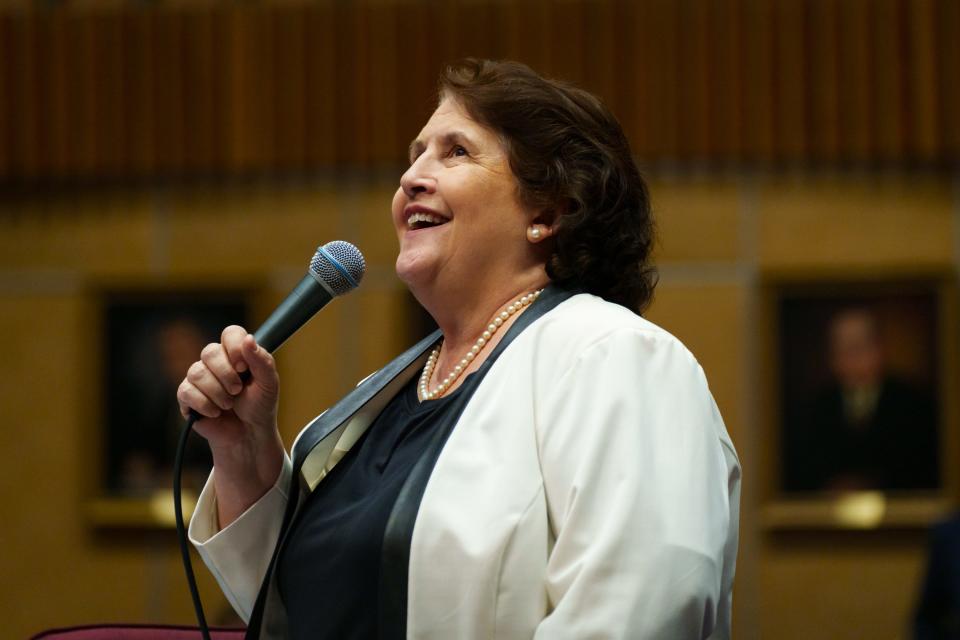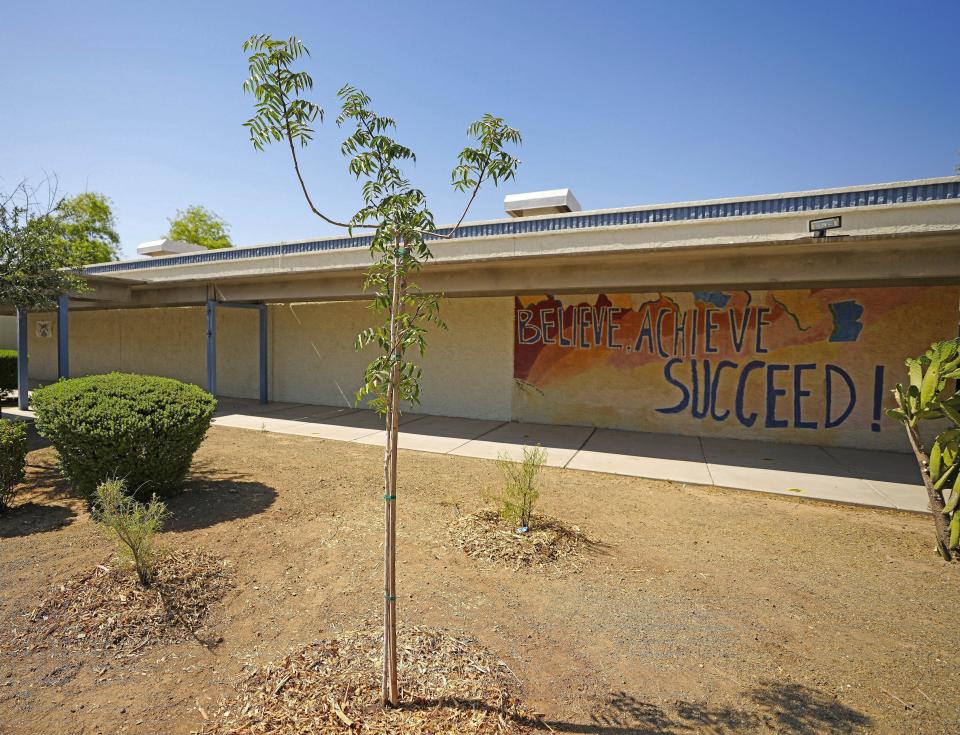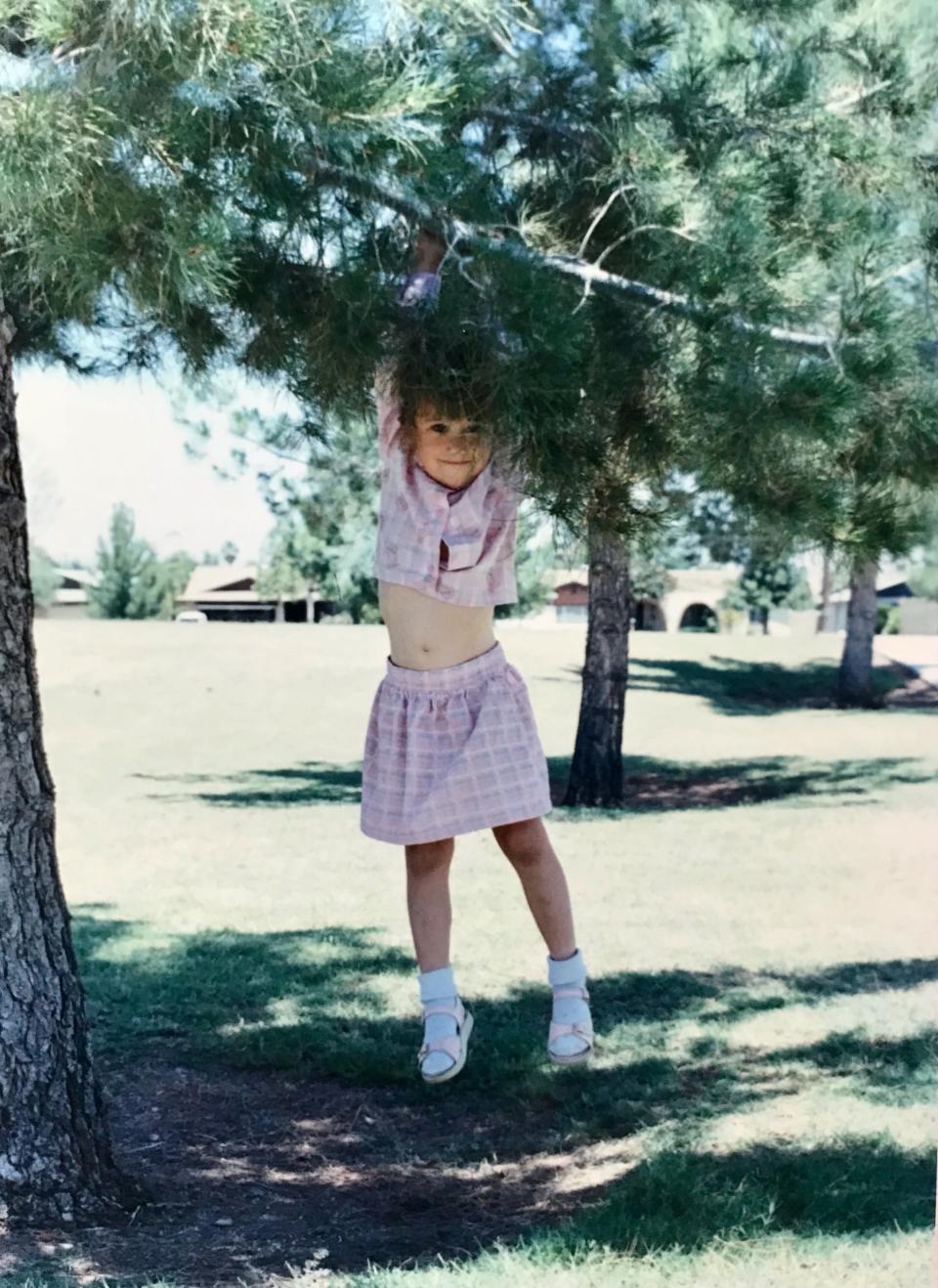'You had me at trees': An easy fix for Arizona school shade takes root. But will it grow?

- Oops!Something went wrong.Please try again later.
Before COVID, Arizona state Sen. Mitzi Epstein visited a classroom of third graders and tried to explain her job as a legislator.
"I said to them that one of the things I’d love to do was plant trees in school yards," said Epstein, D-Tempe. "And I was kind of surprised that there were kids in the classroom who just lit up and got really excited and said 'oh, we LOVE trees!' It has been pretty unanimous.”
In every legislative session since 2019, she has leveraged that universal enthusiasm to plant the seedlings of a bill called "Trees for Kids," which requests funding to install more trees on school campuses across Arizona, with priority going to schools in lower-income neighborhoods that are typically hotter and have less shade than those in more affluent areas.
The benefits of trees are extensive. They provide oxygen, cleaner drinking water and reduced air pollution. Their canopies offer relief from extreme heat by creating shade and releasing water vapor into the air.
Trees also contribute to long-term cooling of the planet. Globally, growing forests pull about one-third of the carbon dioxide emitted by burning fossil fuels from the atmosphere each year, according to the U.S. Forest Service. In urban environments, their shade reduces energy demand for air conditioning in nearby buildings, slowing the progression of climate change by reducing emissions.
These cellulose giants are cool in more ways than just the shade of their photosynthesizing leaves. Research suggests that trees may communicate with each other through root and mycorrhizal networks underground, sharing resources in times of need to support the whole tree community. Their branches provide important habitat for diverse birds, insects, small mammals and children curious about biology.
Woody plants lift up human societies in many ways — not only has the presence of trees been associated with increased property values, but more canopy has also been correlated with lower rates of crime, domestic violence, graffiti and littering. Spending time in and around trees has been connected to both physiological and mental health benefits, with one study finding that "forest bathing" reduced blood pressure and depression and other work linking trees to improvements in student concentration and ADHD symptoms.
Need more reasons to love trees? Epstein didn't.
But while trees and children are generally well loved across party lines, year after year, "Trees for Kids" failed to take root.
"I don’t know of any of my colleagues who object to having more trees," Epstein said. "The use of funds was their main objection."

Trees for kids gets liftoff, finally
This year looked to be the same: plenty of enthusiasm for trees but empty pockets when asking for more of them.
In February, The Arizona Republic reported that Epstein's Senate Bill 1689, requesting $400,000 from the state general fund to plant trees at schools, entered the last week for consideration in the current legislative session without assignment to a committee, essentially ending its journey to sprout change, again. (The same was true for a dozen other bills addressing issues from water to climate to environmental justice, as that story detailed.)
More: Environmentalists grow frustrated as lawmakers cast shade on bills instead of schools
But this time, with a Democratic governor in office, the legislators kept up the pressure for a line item in the state budget even after the bill was dropped.
"The Democratic caucus, we pulled together and said we need to put most of (our part of the budget) towards education and housing," Epstein said. "And then we had a little bit leftover and we put it towards what we think will make a big difference in people's lives without really costing very much at all."
They negotiated $300,000 for the "Trees for Kids" program and $100,000 for a program sponsored by Democratic state Sen. Lela Alston to establish community gardens in schools. Gov. Katie Hobbs seeded the plan when she signed the $17.8 billion state budget on May 11, 2023.
Throughout the years-long process, the idea grew through persistent, nurturing advocacy from environmental and community groups including Trees Matter, Project Roots, Tiger Mountain Foundation, Tucson Clean and Beautiful and Chispa Arizona, which represents issues affecting the LatinX community.
"Even though the bill did not get a hearing, when it came time to provide budget recommendations, the legislators that heard us and understood what Trees for Kids meant, came through and recommended that state funding be allotted for tree-planting in schools," Vania Guevara, advocacy deputy director for Chispa Arizona, told The Republic. "In turn, Governor Katie Hobbs also understood the value of Trees for Kids and took the recommendations."
Chispa Arizona shared statements from youth members of Plantando Semillas (Planting Seeds), its program for youth civic engagement, about the value of trees:
"Trees are good for shade and good air and they are a way of life."
"Help us bring more oxygen to future generations."
"Imagine a school where a child can calmly study under a big tree."
"Please grow more trees in your school. It’s a surefire way to increase your students’ concentration and help with their mental health!"
"We need more trees so we can breath and have shade ‘cuz it’s hot as a sinner in church and kids are feeling sick or faint."

Applications to claim a piece of that $300,000 opened last Wednesday, with project manager Adriana Luna saying in a news conference about her participation in the program, "You had me at trees."
Through the end of the year, grants of between $1,250 and $10,000 each will be distributed on a first-come-first-served basis to schools with the greatest need, defined as those serving 75% of students eligible for free and reduced lunch. After Jan. 1, 2024, any school can apply for remaining funds. The application can be accessed at https://www.treesforkidsaz.org/.
Successful proposals will "demonstrate that the project is intended to support positive student experiences with nature, shade, improved air quality, and campus beautification," according to the website. They must outline a planting and maintenance plan and estimate reasonable expenses for labor and saplings.

Ongoing support needed to nurture growth
One caveat hidden in the fine print of the program is that "Trees for Kids" funding cannot be used for irrigation installation or "capital equipment." This may make it difficult for the target schools, those already operating on strained budgets, to assemble applications or to situate saplings for success in schoolyards.
Allocating funding for trees is just the first of many steps to increasing tree shade, as the Phoenix Office of Heat Response and Mitigation has found with its tree inventories, master plans and programs that jolt tree-cover progress forward with planting initiatives only to see it fall back with tree deaths.
In this harsh desert environment with low soil moisture, drought, rising heat extremes and shrinking water supplies, trees require careful and consistent maintenance to shoot up and leaf out into the canopies desired for shade and tranquility.
During the record-setting heat wave that cooked Phoenix for the entire month of July, for example, the Desert Botanical Garden struggled to protect its signature saguaro cactuses while nurseries fielded calls for help with fruit trees that were losing their leaves, the Associated Press reported.
For the "Trees for Kids" program to truly be a success, it may require permanent status in the state budget and an allowance for maintenance and irrigation costs.
This, says Sandy Bahr, director of the Sierra Club's Grand Canyon Chapter, signifies a pattern in Arizona of ignoring environmental bills and funding essential natural resource programs only temporarily.
Last month, her group released its 2023 report card rating Arizona legislators and the governor on their support for environmental policies.
While the report awards Hobbs, Epstein and other Democratic representatives grades of "A" and names a total of 32 state representatives as "Earth Protectors," it also highlights the dismal success rate of environmental bills the Sierra Club endorsed in February.
More: After historic climate ruling, Arizonans renew push to guarantee a clean environment
Of the 14 bills introducing progress on climate, water and environmental justice in this legislative session, none received a committee hearing. These included initiatives to prepare homes for electric vehicle charging, protect the Upper San Pedro and Verde Valley watersheds, require more public input before permitting polluting facilities, recognize the water needs of ecosystems and wildlife and allow state agencies to take action to reduce greenhouse gas emissions. (More detail in this story from February.)
Of the seven bills introduced in the 2023 session that the group opposed, fearing they would cause damage to the environment or fail to protect water and other natural resources, four passed in the House and Senate, though all were later vetoed by Hobbs.
“None of the bills we supported advanced, other than the caveat that there were aspects that were incorporated into the budget," Bahr said. "The climate resiliency bills not only didn’t advance, they didn’t get a hearing. All those water bills we were supporting didn’t get hearings."
The Arizona State Parks Heritage Fund is one example of an environmental program that used to receive regular funding but now is a topic of negotiation every year. The budget Hobbs signed in May allocated $6 million to it, but Bahr noted it used to automatically receive an annual $10 million. She would like to see similar programs have more permanence in state priorities.
"To me, it was good that it was in there and we acknowledge it was a good step, but why not fund it the full amount that the voters intended?"
A few other programs recognizing the value of natural resources and the need to reduce environmental impacts also received funding in the latest budget, including $15 million for water quality projects, $12.5 million for electric vehicle infrastructure, $4 million for a passenger rail from Phoenix to Tucson and $500,000 for the Arizona Trail.
Read the series: The latest from Joan Meiners at azcentral, a column on climate change that publishes weekly
But Bahr said those gains have to be weighed against climate setbacks like SB1102, a transportation funding bill that she says blocks efforts for electrification by limiting government use of electric vehicles and will also stunt greener transportation options by prohibiting the use of sales tax dollars for light rail expansion.
“There are things that I consider anti-environmental language in there," Bahr said, speaking about the passage of SB1102 but also about a worrying trend she's observed. "Why wouldn’t we want to be doing everything possible to improve air quality and make our roads safer for pedestrians, bicyclists and others? Sometimes in order to get things through, the governor and legislators felt like they had to accept certain poison pills."
Those poison pills introduced as lasting legislation will affect future generations most, Bahr said, placing an environmental weight on young Arizonan's futures that may prove too much for $300,000-worth of trees to bear.

Joan Meiners is the climate news and storytelling reporter at The Arizona Republic and azcentral.com. Before becoming a journalist, she completed a doctorate in ecology. Follow Joan on Twitter at @beecycles or email her at joan.meiners@arizonarepublic.com. Read more of her coverage at environment.azcentral.com.
Sign up for AZ Climate, The Republic's weekly climate and environment newsletter.
Support climate coverage and local journalism by subscribing to azcentral.com at this link.
This article originally appeared on Arizona Republic: Legislators finally fund a program to plant trees at schools

